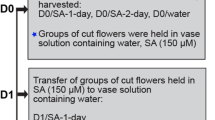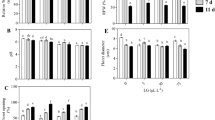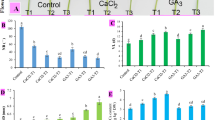Abstract
Cut flowers face the problem of short display life and lose their aesthetic value rapidly. In order to enhance the vase life of gladiolus, its cut spikes were subjected to different levels of gibberellic acid (GA3), viz., 0, 25, 50, 100 and 200 mg L−1 in vase solution, during two consecutive years 2010 and 2011. The GA3 treatment significantly influenced the vase quality attributes and antioxidants capacity of gladiolus cut flowers. Gibberellic acid at 25 mg L−1 caused the longest time taken to open the floret and increased the floret opening, vase life duration and fresh weight. The highest antioxidative activities of superoxide dismutase and free radicals scavenging were also recorded with GA3 at 25 mg L−1. The highest peroxidase, catalase activity and the lowest membrane leakage were recorded with GA3 at 50 mg L−1. Present study concludes that GA3 applied at lower concentrations (25 mg L−1) renders greater beneficial effects on vase life quality, membrane stability and antioxidant activities in gladiolus cut spike, and further higher application rates cause no improvement in the flower longevity.






Similar content being viewed by others
References
Abbasi NA, Kushad MM, Endress AG (1998) Active oxygen-scavenging enzymes activities in developing apple flowers and fruits. Sci Hort 74:183–194
Abdel-Kader DZ (2001) Drought and gibberellic acid-dependant oxidative stress: effect of antioxidant defense system in two lettuce cultivars. Pak J Biol Sci 4(9):1138–1143
Anjum MA, Naveed F, Shakeel F, Amin S (2001) Effect of some chemicals on keeping quality and vase life of tuberose (Polianthes tuberosa L.) cut flowers. J Res Sci 12(1):1–7
Bhattacharjee S, De LC (2005) Post-harvest technology of flowers and ornamental plants. Aavishkar Publishers, Jaipur, India, pp 11–19
Bradford M (1976) A rapid and sensitive method for the quantification of microgram quantities of protein utilizing the principle of protein-dye binding. Ann Biochem 72:248–254
Brand-Williams W, Cuvelier ME, Berset C (1995) Use of free radical method to evaluate antioxidant activity. Lebensmittel Wissenschaft und Technologie 28:25–30
Cong H, Li L, Xu L (2013) Characterizing developmental and inducible differentiation between juvenile and adult plants of Aechmea fasciata treated with ethylene by transcriptomic analysis. Plant Growth Regul 69:247–257
Dhindsa RS, Plumb-Dhindsa D, Thorpe TA (1981) Leaf senescence: correlated with increased levels of membrane permeability and lipid peroxidation, and decreased levels of superoxide dismutase and catalase. J Exp Bot 32:93–101
Eason JR (2002) Sandersonia aurantiaca: an evaluation of postharvest pulsing solutions to maximize cut flower quality. NZ J Crop Hortic Sci 30:273–279
Emongor VE (2004) Effects of gibberellic acid on postharvest quality and vase life of gerbera cut flowers (Gerbera jamesonii). J Agron 3(3):191–195
Ezhilmathi E, Singh VP, Arora A, Sairam RK (2007) Effect of 5-sulfosalicylic acid on antioxidant activity in relation to vase life of gladiolus cut flower. Plant Growth Regul 51(2):99–108
Ferreira DI, van der Merwe JJ, de Swardt GH (1986) Starch metabolism in flowers of senescing gladioli inflorescences. Acta Hort 177:203–210
Goszczynska DM, Zieslin N, Mor Y, Halevy AH (1990) Improvement of postharvest keeping quality of ‘Mercedes’ roses by gibberellin. Plant Growth Regul 9:293–303
Hassan I, Zhang Y, Du G, Wang G, Zhang J (2007) Effect of salicylic acid (SA) on delaying fruit senescence of Huang Kum Pear. Frontiers Agric China 1(4):456–459
Jaime A, Silva TD (2003) The cut flower: postharvest considerations. J Biol Sci 3(4):406–442
Khan MR (1999) Modulation of radio sensitivity with gibberellic acid for cytogenetical, biochemical and genetic spectrum in chickpea (Cicer arientinum L.). Ph.D. dissertation. Quaid-i-Azam University, Islamabad, Pakistan, pp 27
Kumar N, Srivastava GC, Dixit K (2008) Role of sucrose synthase and invertases during petal senescence in rose (Rosa hybrida L.). J Hort Sci Biotech 83:520–524
Mackay WA, Sankhla N, Davis TD (2004) Gibberellic acid and sucrose delay senescence of cut Lupinus densiflorus benth flowers. www.pgrsa.org/ proceed, pp 104–106
Mangave BD, Singh A, Mahatma MK (2013) Effects of different plant growth regulators and chemicals spray on post harvest physiology and vase life of heliconia inflorescence cv. Golden Torch. Plant Growth Regul 69:259–264
Rosenwasser S, Belausov E, Riov J, Vered H, Friedman H (2010) Gibberellic acid (GA3) inhibits ROS increase in chloroplasts during dark-induced senescence of pelargonium cuttings. J Plant Growth Regul 29:375–384
Scandalios JG (1993) Oxygen stress and superoxide dismutase. Plant Physiol 101:7–12
Schopfer P, Plachy C, Frahry G (2001) Release of reactive oxygen intermediates (superoxide radicals, hydrogen peroxide, and hydroxyl radicals) and peroxidase in germinating radish seeds controlled by light, gibberellin, and abscisic acid. Plant Physiol 125:1591–1602
Sing A, Kumar J, Kumar P (2008) Effect of plant growth regulators and sucrose on post harvest physiology, membrane stability and vase life of cut spikes of gladiolus. Plant Growth Regul 55:221–229
Su W, Huang RKL, Chang PS, Chen WS (2001) Improvement of postharvest vase life and flower bud opening in polyanthus tuberosa using gibberellic acid and sucrose. Aust J Expt Agric 41(8):1227–1230
van Doorn WG, Woltering E (2004) Senescence and programmed cell death: substance or semantics? J Exp Bot 55:2147–2153
Woltering EJ, Van Doorn WG (1988) Role of ethylene in senescence of petals morphological and taxonomical relationship. J Exp Bot 39:1605–1616
Wu EY, Wu R, Zhang B, Jiang T, Li N, Qian K, Liu B, Zhang J (2012) GA produced highest growth rate in gardenia plants (Epigenetic instability in genetically stable micropropagated plants of Gardenia jasminoides. Plant Growth Regul 66:137–143
Zhang S (2008) Investigations into senescence and oxidative metabolism in gentian and petunia flowers. Ph.D. dissertation. University of Canterbury, New Zealand, pp 111–112
Acknowledgments
This study was financially supported by Higher Education Commission of Pakistan under HEC Indigenous PhD 5000 Fellowships Program, and technical facilities were provided by PMAS Arid Agriculture University, Rawalpindi, Pakistan.
Author information
Authors and Affiliations
Corresponding author
Rights and permissions
About this article
Cite this article
Saeed, T., Hassan, I., Abbasi, N.A. et al. Effect of gibberellic acid on the vase life and oxidative activities in senescing cut gladiolus flowers. Plant Growth Regul 72, 89–95 (2014). https://doi.org/10.1007/s10725-013-9839-y
Received:
Accepted:
Published:
Issue Date:
DOI: https://doi.org/10.1007/s10725-013-9839-y




